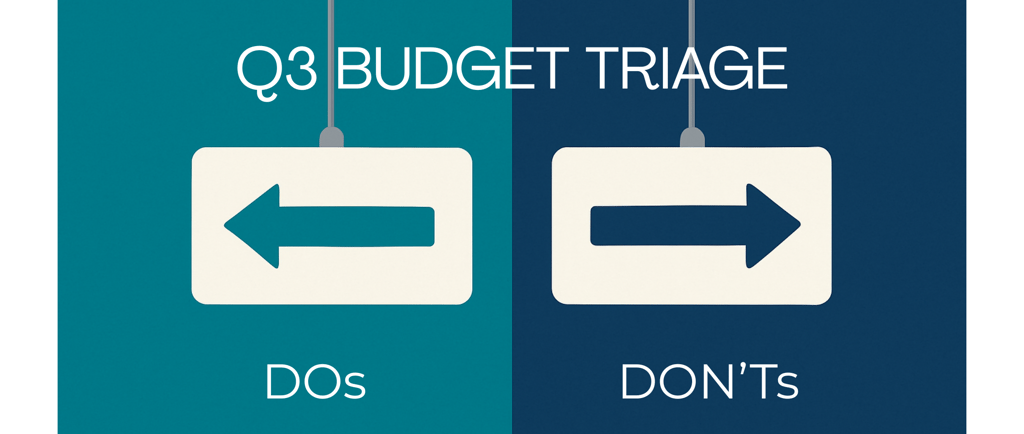BudgetTriage in Q3: What to Do (and NOT to Do) Before Year-End
Get clear on what to keep, cut, and carry forward as Q3 wraps up. This post walks leaders through a practical 5-step budget triage process — with a free downloadable template to help you focus resources, protect momentum, and finish the year strong.
9/15/20253 min read


Ideally, by the time you get to Q3, your company has a 2–3 year business plan in place and knows exactly where it’s trying to go — strategically, not just financially.
But in many organizations, Q3 decisions get driven by short-term pressures: balancing this quarter’s P&L, preserving cash flow, or keeping the stock price from dipping. That’s when teams fall into common traps:
Hanging on to pet projects because they’re personally meaningful or politically popular.
Slashing ten smaller initiatives just to keep on “big” project alive – even is its ROI is shaky.
Spreading cuts evenly across the departments, leaving everyone underfunded and frustrated.
Instead, Q3 should be about clarity and commitment:
Re-centering on your must-win objectives and long-term strategy.
Protecting the projects that truly move the needle.
Cutting with precision, so resources are freed up – no just reduced across the board.
Done well, budget triage isn’t a scramble to save money. It’s a leadership exercise in focus that strengthens your credibility with stakeholders while keeping your teams energized, not deflated — so they can finish the year engaged and motivated, not burned out.
Step 1: Recenter on Strategic Objectives
Before you touch a single budget line, pause and ask: What were our must-win objectives for this year?
Pull up your original annual plan with Objectives and Key Results, then map each project or spend item against those priorities.
A quick way to visualize this is with a Strategic Alignment vs. ROI matrix:
--> High alignment + high ROI: Protect and double down — this is where the impact lives.
--> High alignment + low ROI: Explore ways to improve efficiency or re-scope.
--> Low alignment + high ROI: Challenge the business case — are you solving the right problem?
--> Low alignment + low ROI: Easy candidates to cut.
Step 2: Prioritize What’s Working
Not all projects are created equal — some are already paying off, while others are still unproven. Start by looking for what’s producing results today, whether that’s new revenue, cost savings, market traction, or even strong early adoption.
Create a Quick ROI Table for all major projects. Include:
Key Metric: The leading or lagging KPI that best represents success (e.g., adoption rate, revenue impact, cycle time reduction).
Current ROI: This can be a formal financial ROI (net benefit ÷ cost), a performance improvement relative to baseline (e.g., 1.5x more users adopting), or a qualitative rating (High/Medium/Low) if numbers aren’t available.
Confidence Level: How sure are you that the metric and ROI are accurate and will hold? High confidence means consistent, validated data with a clear causal link to the initiative; medium or low confidence suggests early, volatile, or incomplete data that might shift.
Ideally, you’ve already established KPIs for each project or initiative — but if not, define them now. The combination of ROI and confidence level allows you to make more informed decisions:
High ROI + High Confidence = Protect or double down.
High ROI + Low Confidence = Monitor closely before committing more resources.
Low ROI + High Confidence = Candidate for cutting or re-scoping.
This structured comparison lets you prioritize projects that are pulling the most weight while reducing noise from wishful thinking or anecdotal wins.
Step 3: Make Surgical Cuts
Cutting doesn’t have to feel like failure. Done well, it’s actually a sign of discipline.
Focus first on items that are fairly low risk or highly beneficial to cut — pilots with no traction, overlapping tools, or “nice-to-have” spend that doesn’t change the year’s outcome. Communicate clearly with your teams and external partners — they’ll respect you more for making tough calls transparently than for trying to keep everything alive and burning everyone out.
Step 4: Build a “Resurrection List”
Just because a project doesn’t make the cut this year doesn’t mean it’s dead forever.
Keep a resurrection list — a parking lot of ideas and initiatives that could be restarted next year if funding or capacity returns. Document why each was paused, metrics to monitor, and a target revisit date. This keeps institutional memory intact and prevents teams from feeling like their work just disappeared.
Step 5: Strengthen the Narrative
Budget triage isn’t just about dollars — it’s about giving everyone confidence that the company is on the right track and their efforts matter.
When you can show your board, investors, and especially your own internal teams that you’ve made intentional, data-driven decisions, you build credibility and trust.
And you enter Q4 sharper, leaner, and better positioned to hit next year’s targets with focus.
Wrap-Up: Discipline Creates Freedom
Budget triage isn’t about cutting for the sake of cutting — it’s about clarifying and committing.
If you want a simple way to get started, I’ve created a free set of Q3 Budget Triage Matrices — including:
--> A strategic alignment vs ROI grid
--> A quick ROI scan table
--> A risk/benefit matrix for cuts
--> A resurrection list template
SYNERGYLM, LLC
liz.michael@synergylm.net
7901 4th St. N #25825
St. Petersburg, FL 33702
© 2025. All rights reserved.


